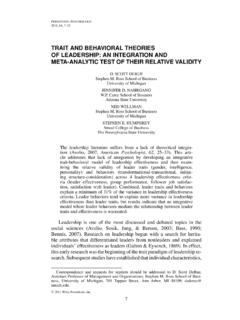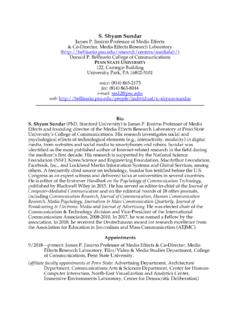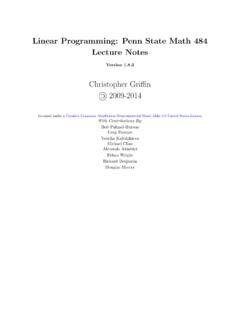Transcription of 1 INTRODUCTION TO DIFFERENTIAL EQUATIONS
1 11 INTRODUCTION TO and EQUATIONS as Mathematical ModelsCHAPTER 1 IN REVIEWThe words differentialandequationscertainly suggest solving some kind ofequation that contains derivatives y ,y , .. Analogous to a course in algebra andtrigonometry, in which a good amount of time is spent solving EQUATIONS such asx2 5x 4 0 for the unknown number x, in this course oneof our tasks will beto solve DIFFERENTIAL EQUATIONS such as y 2y y 0 for an unknown functiony (x).The preceding paragraph tells something, but not the complete story, about thecourse you are about to begin. As the course unfolds, you will see that there is moreto the study of DIFFERENTIAL EQUATIONS than just mastering methods that someone hasdevised to solve first things first. In order to read, study, and be conversant in a specializedsubject, you have to learn the terminology of that discipline. This is the thrust of thefirst two sections of this chapter. In the last section we briefly examine the linkbetween DIFFERENTIAL EQUATIONS and the real world.
2 Practical questions such as Howfast does a disease spread? How fast does a population change?involve rates ofchange or derivatives. As so the mathematical description or mathematicalmodel of experiments, observations, or theories may be a DIFFERENTIAL AND TERMINOLOGYREVIEW MATERIAL Definition of the derivative Rules of differentiation Derivative as a rate of change First derivative and increasing/decreasing Second derivative and concavityINTRODUCTIONThe derivative dy dxof a function y (x) is itself another function (x)found by an appropriate rule. The function is differentiable on the interval ( , ), andby the Chain Rule its derivative is . If we replace on the right-hand side ofthe last equation by the symbol y, the derivative becomes.(1)Now imagine that a friend of yours simply hands you equation (1) you have no idea how it wasconstructed and asks, What is the function represented by the symbol y? You are now face to facewith one of the basic problems in this course: How do you solve such an equation for the unknown function y (x)?
3 Dydx >dx CHAPTER 1 INTRODUCTION TO DIFFERENTIAL DEFINITIONThe equation that we made up in (1) is called a proceeding any further, let us consider a more precise definition ofthis EquationAn equation containing the derivatives of one or more dependent variables,with respect to one or more independent variables, is said to be a differentialequation (DE).To talk about them, we shall classify DIFFERENTIAL EQUATIONS by type, order, BY TYPEIf an equation contains only ordinary derivatives ofone or more dependent variables with respect to a single independent variable it issaid to be an ordinary DIFFERENTIAL equation (ODE).For example,A DE can contain morethan one dependent variable(2)are ordinary DIFFERENTIAL EQUATIONS . An equation involving partial derivatives ofone or more dependent variables of two or more independent variables is called adydx 5y ex, d2ydx2 dydx 6y 0, and dxdt dydt 2x yb bpartial DIFFERENTIAL equation (PDE).
4 For example,(3)are partial DIFFERENTIAL EQUATIONS .*Throughout this text ordinary derivatives will be written by using either theLeibniz notationdy dx,d2y dx2,d3y dx3,.. or theprime notationy ,y ,y ,..By using the latter notation, the first two DIFFERENTIAL EQUATIONS in (2) can be writtena little more compactly as y 5y exandy y 6y 0. Actually, the primenotation is used to denote only the first three derivatives; the fourth derivative iswritteny(4)instead of y . In general, the nth derivative of yis written dny dxnory(n).Although less convenient to write and to typeset, the Leibniz notation has an advan-tage over the prime notation in that it clearly displays both the dependent andindependent variables. For example, in the equationit is immediately seen that the symbol xnow represents a dependent variable,whereas the independent variable is should also be aware that in physicalsciences and engineering, Newton s dot notation(derogatively referred to by someas the flyspeck notation) is sometimes used to denote derivatives with respectto time the DIFFERENTIAL equation d2s dt2 32 becomes s 32.
5 Partialderivatives are often denoted by a subscript notationindicating the indepen-dent variables. For example, with the subscript notation the second equation in(3) becomes uxx utt BY ORDERT heorder of a DIFFERENTIAL equation(eitherODE or PDE) is the order of the highest derivative in the equation. For example,is a second-order ordinary DIFFERENTIAL equation. First-order ordinary differentialequations are occasionally written in DIFFERENTIAL form M(x,y)dx N(x,y)dy example, if we assume that ydenotes the dependent variable in (y x)dx 4xdy 0, then y dy dx, so by dividing by the DIFFERENTIAL dx, weget the alternative form 4xy y x. See the Remarksat the end of this symbols we can express an nth-order ordinary DIFFERENTIAL equation in onedependent variable by the general form,(4)whereFis a real-valued function of n 2 variables: x,y,y ,.., y(n). For both prac-tical and theoretical reasons we shall also make the assumption hereafter that it ispossible to solve an ordinary DIFFERENTIAL equation in the form (4) uniquely for theF(x,y,y.)
6 , y(n)) 0first ordersecond order 5()3 4y exdy dxd2y dx2d2x dt2 16x 0unknown functionor dependent variableindependent variable 2u x2 2u y2 0, 2u x2 2u t2 2 u t, and u y v AND TERMINOLOGY 3*Except for this introductory section, only ordinary DIFFERENTIAL EQUATIONS are considered in A FirstCourse in DIFFERENTIAL EQUATIONS with Modeling Applications, ninth edition . In that text thewordequationand the abbreviation DE refer only to ODEs. Partial DIFFERENTIAL EQUATIONS or PDEsare considered in the expanded volume DIFFERENTIAL EQUATIONS with Boundary-Value Problems,Seventh derivative y(n)in terms of the remaining n 1 variables. The differentialequation,(5)wherefis a real-valued continuous function, is referred to as the normal form of (4).Thus when it suits our purposes, we shall use the normal formsto represent general first- and second-order ordinary DIFFERENTIAL EQUATIONS . For example,the normal form of the first-order equation 4xy y xisy (x y) 4x; the normalform of the second-order equation y y 6y 0 is y y 6y.
7 See the BY LINEARITYA nnth-order ordinary DIFFERENTIAL equation (4)is said to be linearifFis linear in y,y ,..,y(n). This means that an nth-order ODE islinear when (4) is an(x)y(n) an 1(x)y(n 1) a1(x)y a0(x)y g(x) 0 or.(6)Two important special cases of (6) are linear first-order (n 1) and linear second-order (n 2) DEs:. (7)In the additive combination on the left-hand side of equation (6) we see that the char-acteristic two properties of a linear ODE are as follows: The dependent variable yand all its derivatives y ,y , .., y(n)are of thefirst degree, that is, the power of each term involving yis 1. The coefficients a0,a1, .., anofy,y , .., y(n)depend at most on theindependent variable equationsare, in turn, linear first-, second-, and third-order ordinary DIFFERENTIAL EQUATIONS . Wehave just demonstrated that the first equation is linear in the variable yby writing it inthe alternative form 4xy y x. A nonlinearordinary DIFFERENTIAL equation is sim-ply one that is not linear.
8 Nonlinear functions of the dependent variable or its deriva-tives, such as sin yor , cannot appear in a linear equation. Thereforeare examples of nonlinear first-, second-, and fourth-order ordinary DIFFERENTIAL equa-tions, was stated before, one of the goals in this course is to solve, orfind solutions of, DIFFERENTIAL EQUATIONS . In the next definition we consider the con-cept of a solution of an ordinary DIFFERENTIAL term:coefficient depends on ynonlinear term:nonlinear function of ynonlinear term:power not 1(1 y)y 2y ex, siny 0,andd2y dx2 y2 0d4y dx4ey (y x)dx 4xdy 0, y 2y y 0, and d3ydx3 xdydx 5y exa1(x)dydx a0(x)y g(x) and a2(x)d2ydx2 a1(x)dydx a0(x)y g(x)an(x)dnydxn an 1(x)dn 1ydxn 1 a1(x)dydx a0(x)y g(x)dydx f(x,y) and d2ydx2 f(x,y,y )dnydxn f(x,y,y , .. , y(n 1))4 CHAPTER 1 INTRODUCTION TO DIFFERENTIAL EQUATIONS right-hand side: side: y 2y y (xex 2ex) 2(xex ex) xex 0,116 x4y1/ 2 14x2right-hand side: xy1/ 2 x 116x4 1/ 2 x 14x2 14x3,left-hand side: dydx 116 (4 x3) 14x3,y 2y y 0; y xexdy>dx xy1/ 2; y 116 x4y (x, (x), (x).)
9 , (n)(x)) 0 for all x in AND TERMINOLOGY 5 DEFINITION Solution of an ODEAny function , defined on an interval Iand possessing at least nderivativesthat are continuous on I, which when substituted into an nth-order ordinarydifferential equation reduces the equation to an identity, is said to be asolutionof the equation on the other words, a solution of an nth-order ordinary DIFFERENTIAL equation (4) is a func-tion that possesses at least nderivatives and for whichWe say that satisfiesthe DIFFERENTIAL equation on our purposes we shall alsoassume that a solution is a real-valued function. In our introductory discussion wesaw that is a solution of dy dx the interval ( , ).Occasionally, it will be convenient to denote a solution by the alternativesymboly(x).INTERVAL OF DEFINITIONYou cannot think solutionof an ordinary differentialequation without simultaneously thinking interval Iin Definition variously called the interval of definition,the interval of existence,the intervalof validity,or the domainof the solutionand can be an open interval (a,b), a closedinterval [a,b], an infinite interval (a, ), and so 1 Verification of a SolutionVerify that the indicated function is a solution of the given DIFFERENTIAL equation onthe interval ( , ).
10 (a)(b)SOLUTIONOne way of verifying that the given function is a solution is to see, aftersubstituting, whether each side of the equation is the same for every xin the interval.(a)Fromwe see that each side of the equation is the same for every real number is, by definition, the nonnegative square root of .(b)From the derivatives y xex exand y xex 2exwe have, for every realnumber x,Note, too, that in Example 1 each DIFFERENTIAL equation possesses the constant so-lution y 0, x . A solution of a DIFFERENTIAL equation that is identicallyzero on an interval Iis said to be a trivial CURVEThe graph of a solution of an ODE is called a is a differentiable function, it is continuous on its interval Iof defini-tion. Thus there may be a difference between the graph of the function and thegraph of the solution . Put another way, the domain of the function need not bethe same as the interval Iof definition (or domain) of the solution.
















